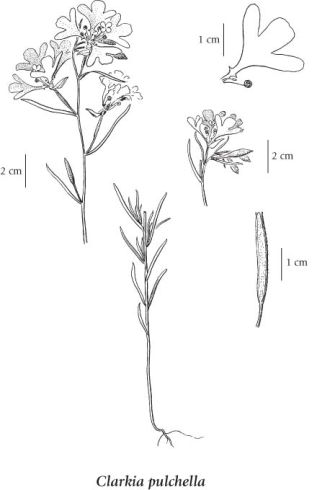pink fairies (pinkfairies)
Onagraceae (Evening Primrose family)
Introduction to Vascular Plants
Photograph
© Gordon Neish (Photo ID #56329)
Species Information
General:
Annual herb from a short taproot; stems 10-50 cm tall, simple to freely branched, short stiff-hairy.
Leaves:
Alternate, linear lance- to spoon-shaped, 2-7 cm long, 2-10 mm wide, entire to finely toothed.
Flowers:
Inflorescence a few-flowered, short raceme, buds nodding; hypanthium 1-3 mm long, glabrous inside; corollas slightly irregular; petals lavender to rose-purple, 3-lobed, middle lobe the widest, narrowed to a slender claw, short tooth on each side near the base; sepals usually joined and turned to one side; fertile stamens 4, the anthers coiling after shedding pollen, the others reduced and without functional pollen; stigmas oval-oblong, 1-3 mm long, white.
Fruits:
Capsules, straight or curved, about 2 cm long.
Illustration

If more than one illustration is available for a species (e.g., separate illustrations were provided for two subspecies) then links to the separate images will be provided below. Note that individual subspecies or varietal illustrations are not always available.
Illustration Source: The Illustrated Flora of British Columbia
USDA Species Characteristics
Flower Colour:
Purple
Blooming Period:
Mid Spring
Fruit/Seed characteristics:
Colour: Brown
Present from Spring to Summer
Source: The USDA
Ecology
The table below shows the species-specific information calculated from
original data (BEC database) provided by the BC Ministry of Forests and Range.
(Updated August, 2013)
| Site Information |
Value / Class |
||
|
Avg |
Min |
Max |
|
| Elevation
(metres) |
818 | 547 | 1177 |
| Slope
Gradient (%) |
48 | 0 | 80 |
|
Aspect (degrees) |
188 | 40 | 260 |
| Soil
Moisture Regime (SMR) [0 - very xeric; 4 - mesic; 8 - hydric] |
1 | 0 | 3 |
| Modal
Nutrient Regime
Class |
C | ||
| #
of field plots species was recorded in: |
29 | ||
| Modal
BEC Zone Class |
ICH | ||
|
All BEC Zones (# of stations/zone) species was recorded in |
ICH(11), IDF(10), PP(8) | ||
|
Source:
Klinkenberg 2013
|
|||
Habitat and Range
Dry, open areas in the steppe and montane zones; infrequent in S BC east of the Coast-Cascade Mountains; S to OR, ID and MT.Status Information
Taxonomic Keys
1. Petals not narrowing to a claw at the base; flowers regular, closing at night.
2. Sepals usually joined and turned to one side; ovaries and immature fruits 4-grooved; stigmas 1-6 mm long........................C. amoena 1. Petals with a distinct, narrow claw at the base; flowers slightly irregular, not closing at night.
3. Petals 3-lobed; fertile stamens 4; leaves often alternate........................C. pulchella |